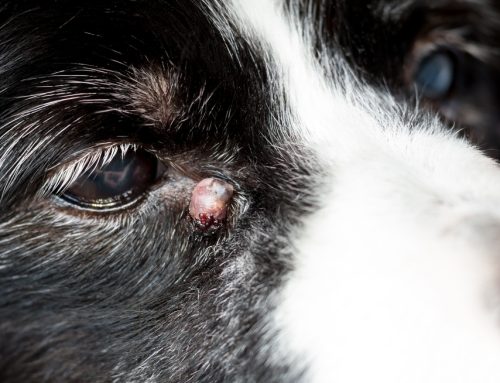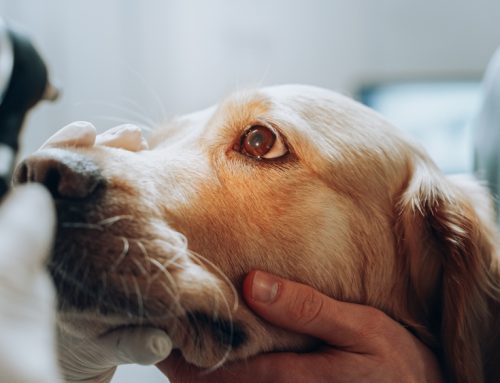Your dog’s eyes are lined with a thin pink tissue called conjunctiva that covers the inside of the eyelids, as well as the white portion of the eyeball. The conjunctiva can become red when irritated or inflamed, and result in a condition known as conjunctivitis. In humans, we know this lovingly as the dreaded “pink eye,” typically caused by a contagious bacterial or viral infection. In dogs, however, the cause is rarely infectious, and may point to an underlying allergic condition more akin to human hay fever. May is Allergy and Asthma Awareness Month, so our Veterinary Vision Center team would like to share some information about allergic eye conditions in dogs.
Canine eye allergies fall into two categories:
- Follicular conjunctivitis, which affects young dogs
- Allergic conjunctivitis, which affects adult dogs, who typically also suffer from allergic skin disease.
Both conditions result from an immune system overreaction to normal environmental stimuli, and are treated with similar medications. Prior to starting treatment for an allergic eye condition, we’ll perform a thorough eye examination to rule out other common causes of conjunctivitis, such as dry eye, abnormal eye lashes, or abnormal eyelid positioning.
Follicular conjunctivitis in young dogs
Follicular conjunctivitis is typical in a happy, healthy young dog who has red goopy eyes. Short courses of medication usually work, but the problem will keep coming back until the pet is referred to us for evaluation. The conjunctiva contain immune cells (i.e., lymphoid follicles) that normally aren’t visible, but in a pet with follicular conjunctivitis, the body overreacts to allergens such as pollen, dust, or grass, and the follicles become enlarged in response. The reaction is an allergic-type response, but is caused by a defect in the immune system rather than a true allergy. Young dogs are affected because their immune system hasn’t yet matured, but typically they outgrow the condition by age 2. Follicular conjunctivitis signs include red eyes, watery or mucoid discharge, rubbing at the eyes, and visible follicles on the third eyelid conjunctiva.
Allergic conjunctivitis in adult dogs
Adult dogs with recurrent or persistent conjunctivitis that cannot be attributed to another underlying eye disease may have allergic conjunctivitis. Usually, these dogs have been diagnosed with systemic allergies (i.e., atopy) and show other signs, including itching, skin and ear infections, and hair loss, that coincide with conjunctivitis flare-ups. Sometimes only the eyes are affected, and depending on the offending allergen, flare-ups may be seasonal. Similar to follicular conjunctivitis, this allergy causes redness, discharge, and eye rubbing, although lymphoid follicle enlargement is typically not seen.
Treatment of allergic eye conditions in dogs
Follicular conjunctivitis is self-limiting, meaning the condition will eventually resolve on its own. However, pets with copious discharge, or who cause self-trauma from itching or otherwise appear uncomfortable, may be treated to ease symptoms while their immune system matures and adjusts to tamp down the overactive immune response. Treatment is usually continued for several months before tapering or stopping, and may include:
- Eye flushing — Sterile eye wash can rinse away debris, allergens, and discharge, to reduce the immune response and improve comfort.
- Topical steroid medications — Steroid eye medications can reduce conjunctival inflammation.
- Topical immunomodulators — Eye medications, including tacrolimus and cyclosporine, can help regulate the eye’s local immune system and reduce the overactive immune response.
These treatments may also be used for allergic conjunctivitis, especially if only the eye is affected. For dogs with conjunctivitis associated with systemic allergies, other therapies to control their infection may include:
- Oral antihistamines — Antihistamines (i.e., Zyrtec, Benadryl) may help control mild generalized allergies.
- Topical antihistamines — Eye drop antihistamines, such as Zaditor, may be recommended to help with eye itching and redness.
- Dermatology consultation — Dogs with severe allergies and conjunctivitis may require oral steroids, immunosuppressants, or immunotherapy to desensitize them to their allergens. We may recommend a referral to a veterinary dermatologist, who can help you get better control of your pet’s allergies.
Preventing allergic conjunctivitis in dogs

If your pet is prone to eye allergies, you can take steps to reduce contact with airborne allergens and reduce the impact of flare-ups. Always follow our veterinarian’s treatment plan, and give medications as prescribed. Additionally, your pet may benefit from:
- Gel or ointment — Apply a lubricant gel or ointment to create a barrier on the eye prior to walks or exposure to the outdoors.
- Eye wash — Use eye wash to rinse debris from the eyes, as needed, prior to applying topical medication—never immediately afterward.
Spring is here, and allergy season also will be here in no time. If you believe your pet is suffering from an allergic eye condition, or you’ve noticed any redness, discharge, or rubbing at the eyes, call us to schedule an appointment with your Veterinary Vision Center team.







Leave A Comment